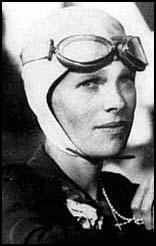Amelia Earhart

Amelia Earhart, the daughter of a lawyer, was born in Atchison, Kansas, on 24th July, 1897. Amelia Earhart became interested in aviation when she saw her first aircraft at the Iowa State Fair in 1907.
In 1917 Amelia Earhart moved to Toronto and served as a Voluntary Aid Detachment nurse at a military hospital until November 1918. After the war she became a medical student at Columbia University. However, she did not finish the course and in 1920 went to live with her parents in California. Soon afterwards she was taken up in a biplane for a 10 minute flight over Los Angeles.
Amelia Earhart was impressed with the experience and began receiving flying lessons from Anita Snook. A few months later she purchased a aircraft she called The Canary. Snook did not rate Earhart as a great flyer and she did have several accidents during this period. Earhart did not lack self-confidence and in October, 1922, she set a women's altitude record when she reached 14,000 feet.
In 1925, Amelia Earhart began work as a social worker in Boston. She remained interested in aviation and joined the National Aeronautic Association and helped to publicize the idea of women pilots. This resulted in her being asked to accompany Wilmer Stultz and Louis Gordon on a flight across the Atlantic. On 18th June, 1928, the team left for Halifax, Nova Scotia. Flying through dense fog for most of their journey, they landed at Burry Port in South Wales.
Earhart published a book on the flight, 20 hours, 40 minutes. She also wrote regular articles on aviation for Cosmopolitan and other magazines. She continued to fly and in 1930 broke several women's speed records in her Lockheed Vega aircraft.
Earhart's next ambition was to become the first woman to fly solo across the Atlantic. On 20th May, 1932, she flew her Lockheed Vega from Harbour Grace, Newfoundland, to Londonderry, Northern Ireland. This flight broke several records. As well as being the first woman to fly the Atlantic solo it was also the longest non-stop distance flown by a woman. She also became the first person to fly the Atlantic twice.
On her return to America she received a tickertape parade in New York. President Herbert Hoover also presented her with the Special Gold Medal from the National Geographic Society.
Earhart followed this achievement with a flight from Hawaii to California. Ten pilots had already lost their lives attempting this crossing but Earhart successfully completed the journey on 11th January, 1935.
Earhart now decided to try fly around the world. The Lockheed Electra 10E was chosen as the plane for the flight and Frederick Noonan agreed to become her navigator. The first leg of the journey was from Oakland to Hawaii. Unfortunately on March 17, 1935, Earhart had an accident while taking off and her aircraft had to be sent back to California for repairs.
Earhart decided to begin her second attempt from Los Angeles, California on May 21, 1937. The first destination was San Juan, Puerto Rico. This was followed by trip to South America before going on to Africa and the Red Sea. Earhart then became the first woman to fly non-stop from the Red Sea to India.
On 17th June Earhart and Noonan left Karachi. After stopping off at Rangoon, Bangkok and Singapore the Lockheed Electra 10E reached Bandoeng. They remained there for ten days as some faulty equipment had to be repaired.
Earhart left Bandoeng for Port Darwin, Australia on 27th June. They then moved on to New Guinea. At this point they had flown 22,000 miles. With less than 7,000 miles to go, the couple left the island on 2nd July. They never reached their destination and it is believed the plane went down about 100 miles off the coast of Howland Island.
Amelia Earhart autobiography, Last Flight, was published posthumously in 1938.
